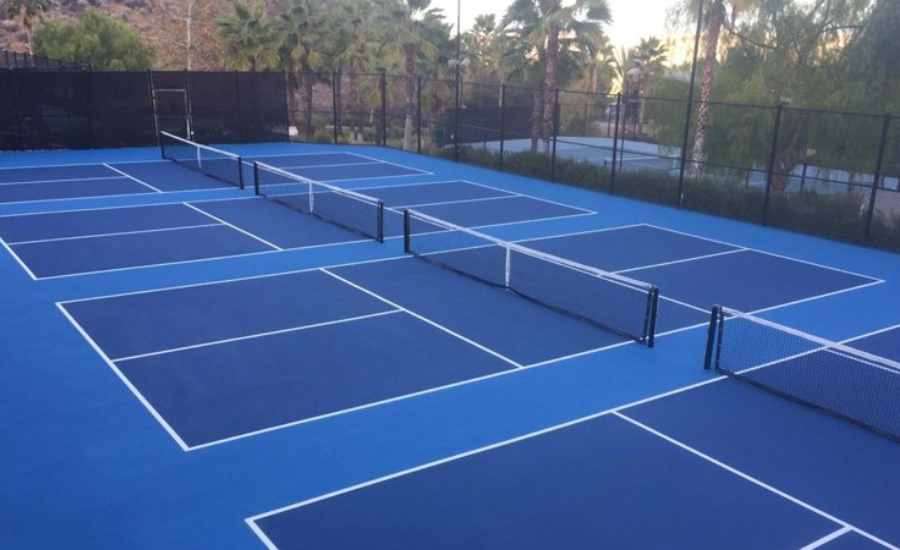Introduction
Tennis has fascinated fans for ages with its unique blend of athleticism, strategy, and precision. Whether you’re a pro, weekend warrior, or tennis fan, the court you play on might affect your experience. Tennis court builders‘ skill literally helps here. Our essay will explore the intriguing world of tennis court builders, their function, the construction process, and the critical components that make the perfect tennis court.
The Role of Tennis Court Builders
Tennis courts are designed and built by constructors. Tennis aficionados, from beginners to pros, depend on them for safe and high-quality practise and competition facilities. Building tennis courts involves site selection, design, building, and upkeep.
Choice of Site
Site selection is the first critical tennis court building phase. Topography, soil composition, drainage, and accessibility are considered by tennis court builders. These factors are crucial to building a stable court without waterlogging, which can influence playability.
Design
The design process begins after site selection. Tennis court builders collaborate with architects and landscape designers to establish an industry-standard blueprint. Design considerations include dimensions, orientation, fencing, lighting, and surface materials. Each feature enhances court functionality and aesthetics.
Construction
The vision is released throughout construction. Excavating, laying the foundation, and installing drainage, fencing, and lighting require skilled labour and specialized equipment. Building the court to precise measurements and regulations requires meticulous attention to detail.
Maintenance
After construction, the tennis court needs continual maintenance to maintain its quality and durability. Tennis court builders may offer maintenance or advice to owners. Resurfacing, net replacement, and cleaning are regular maintenance.
Key Factors in Tennis Court Construction
Tennis court builders must consider numerous important elements that affect performance and durability to design a high-quality court.
Surface Material
Surface material is crucial to tennis court building. Different materials play differently and demand different maintenance. Common tennis court surfaces:
Hard Courts: Concrete or asphalt courts are durable and bounce balls consistently. Hard courts need regular resurfacing to perform well.
Clay Courts: Crushed brick or shale courts are famous for their slower pace and pleasant playing surface. However, they need constant hydration and rolling to be healthy.
Grass Courts: With their natural surface, grass courts offer a unique playing experience. They need frequent mowing and watering to avoid wear and tear.
Synthetic Courts: Acrylic or rubber courts offer speed and playing variety. They require less upkeep than natural surfaces.
Synthetic Courts: Climate, budget, and player preferences affect surface material selection.
Lighting
Tennis courts need good illumination for nighttime play and safety. To maximize player visibility, tennis court builders must choose and install lighting fixtures to reduce shadows and glare.
Fencing
Fencing is essential for court safety and defines its borders. It shields balls from neighboring courts and keeps unauthorized people off the court. Fencing material and height impact court aesthetics and functionality.
Drainage
Water collection on the court can cause slick surfaces and damage over time, making effective drainage systems essential. Tennis court builders must create water-removal and erosion-prevention drainage systems.
Dimensions
International rules dictate tennis court dimensions. Standardised court dimensions, net height, and baseline-to-net distance provide fairness and consistency in gameplay.
Technological Advancements in Tennis Court Construction
Tennis court construction has benefited from technology like other industries. Innovations have enhanced tennis court quality, durability, and playability.
Court Surfaces
Modern surface materials are designed for longevity and performance. Cushioned surfaces reduce player injuries by absorbing shock. Acrylic coatings have also prolonged hard court lifespans.
Subsurface irrigation
Some tennis courts have subterranean watering systems that evenly distribute water. Water conservation and stable playing conditions are especially important for clay courts.
LED Lights
Due to its energy efficiency and durability, LED tennis court lighting is the standard. LED fixtures allow accurate light intensity control and may be set for optimal playing conditions.
Court Supplies
Technological advances have reached court accessories. Electronic scoreboards and video replay systems improve professional tournament spectator experiences, while remote-controlled ball machines allow solo practice.
Sustainability in Tennis Court Construction
Sustainability has become more important in all businesses, especially sports infrastructure. Many tennis court builders try to reduce their environmental impact during construction and upkeep.
Eco-Friendly Materials
Builders are investigating eco-friendly court and fencing materials. Recycled materials like tyre rubber are used to make sustainable surfaces. For fencing and seating, sustainable wood or composite materials are being investigated.
Lights that save energy
LED fixtures save electricity and last longer, saving waste and replacements.
Conserving Water
Tennis courts are being designed with subsurface irrigation and rainwater harvesting to conserve water.
Maintenance Methods
Biodegradable cleaning products and chemical reduction are becoming industry standards.
Conclusion
The unsung heroes of the ultimate tennis experience are tennis court builders. They provide safe, high-quality courts for all levels with their site selection, design, building, and maintenance skills. Technology and a focus on sustainability are improving tennis court construction to improve playing conditions and reduce environmental impact. Tennis enthusiasts and professionals can appreciate the beauty and science of court design.

